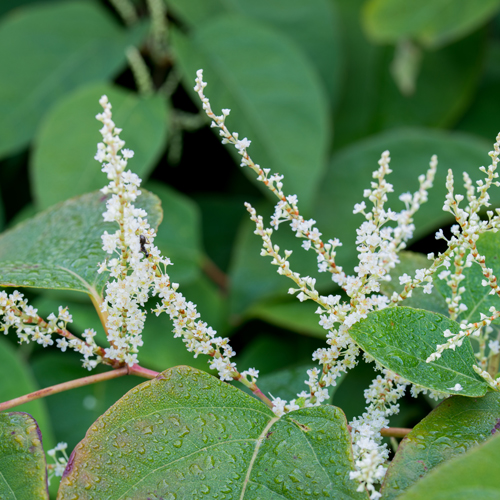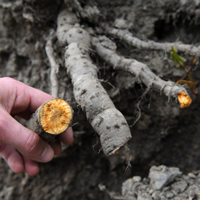Fallopia Japonica or Japanese Knotweed, as it is commonly known, is an invasive plant that spreads rapidly.
It can be seen growing in late spring, through summer & into autumn. The plant dies back to ground levels in winter; however, its rhizomes (underground stems) remain deep underground ready for the new season.
Removal of the plant is difficult and can lead it to spread further if it isn’t correctly eradicated.
So, do you have a Japanese Knotweed Infestation?
Flourishing Japanese Knotweed has some very distinct features that help to identify it. These can change depending on the time of year and stages of growth:

Mature leaves are heart or shovel-shaped with a pointed tip and are green in colour.
They can grow up to 14cm in length and are arranged in a zig-zag pattern along the stem.
Young leaves are often found at ground level and emerge from reddish buds. The leaves themselves can be red or light green in colour.
Leaves can be seen growing in spring and will have a reddish or light green colour as previously mentioned. The leaves emerge at a rapid rate and could also be bright green at this stage.
During the summer months, leaves will have their distinctive shovel shape with a pointed tip and will be bright green in colour.
Moving into autumn, the leaves will begin to die back and turn brown and may begin to fall from the plant.
In winter all the leaves will have died in preparation for the winter months.

Flowers begin to bloom in summer and may appear in August and September. They can be recognised with their white or yellowish colour and cluster formation. The cluster of flowers can grow up to 10cm in length from the point where the leaf joins the stem.
During autumn & winter, you may see the flower dying back and the clusters beginning to slump. They can also be slightly discoloured until they are completely dead and no longer present.

Stems are reddish in colour and are similar in appearance to bamboo and if snapped will be hollow. The stems can grow more than 2 metres in height.
During spring you will see spear or asparagus-like tips as the new stems begin their growth. At this stage, it is often red in colour.
In summer months the stem can begin to rapidly grow in height and thickness. The stem will also have noticeable speckles with a purple colour.
Autumn sees the discolouration of the stem to a deep brown as it readies for the winter months.
During winter the steams will resemble wood in appearance, and will often be broken.

The roots of the plant can grow 3 metres down and spread 7 metres wide, which makes it difficult to remove. The rhizomes are dark brown in appearance and have a bright orange colour inside.
The invasive plant is now widespread throughout the UK and thrives in the moist climate. It can be seen growing in any soil, however, it is often established alongside railways, canals, rivers, streams & roadsides.
It is also common to find Knotweed growing in urban areas and has been seen growing through weak spots in roads or even walls!
to put it simply, it grows anywhere it can take root.
During the summer months, Japanese Knotweed has been seen to grow as quickly as 10cm per day.
Japanese Knotweed produces seeds but does not spread through this natural method in the UK. The main method of spreading is through the stems and rhizomes.
The crown of the plant produces new above-ground stems rapidly. The crown can survive drying and will produce new canes if existing canes have dried and dyed.
A new plant can grow from rhizome fragments as small as 1cm in size which is why cutting the plant can cause even more issues.
Yes. If you allow Japanese Knotweed or contaminated soil to spread into the wild can be an offence and could result in a fine of up to £5,000, or even a prison sentence!
Although it is renowned to be a challenge to eradicate Japanese Knotweed there are several effective methods in destroying the invasive weed:
The most effective method in removing invasive species soil is to excavate the infected area. Care must be taken onsite not to spread the rhizomes because they can regrow a new plant and create new cross-contamination. The material must then be buried at permitted disposal sites that have a suitable permit.
The plant can be sprayed or injected with chemicals to stop it from spreading. You must only use approved herbicides outlined by the HSE – https://www.hse.gov.uk/pesticides/
This method can take up to 3 years and the invasive plant will need continual spraying to ensure its eradication. If successful, the underground rhizomes will become dormant.
If a business wants to burn Japanese Knotweed they must:
Japanese Knotweed crowns and rhizomes can survive burning so you must dispose of any remaining material at a permitted landfill site where it can be buried.
We have partnered with permitted Japanese Knotweed disposal sites in the North West & the Midlands. Get in touch to find out more on 0161 647 7409 or by clicking HERE